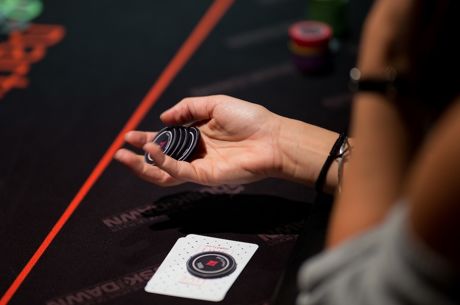10 Tips for Sit & Go Success: Early Level Play

Last time, we discussed some of the practical applications of ICM, including in the early levels of a sit & go. This week, we will expand our consideration of early level play in more detail.
Tight Is Right
From our ICM discussion, you know that the chips you earn are worth less than the chips you lose. In fact, every time you get involved in a hand this lost equity is shared among the other players at the table. Why give them equity for free? In the early levels, you should generally play tight and let the gamblers take all the risks which allows you to gain equity for folding.
That said, even though you may feel like you have a lot of chips at the start of a sit & go, the blinds go up very quickly in SNGs. A big starting stack becomes a medium stack and then a short stack fast enough as is. You shouldn't accelerate this process by playing a lot of mediocre hands.
A good early position opening range for the early levels is something along the lines of 77+, AQo+, KQs+, AJs+. This range can be expanded slightly as you get closer to the button, but don't go overboard. It doesn't take much to find yourself with too wide of an opening range.
Remember, during the first couple of levels of a sit & go the blinds are very small relative to the size of your stack. For example, if you play online poker and sit down at a regular nine-handed SNG on 888poker, you'll begin with a 1,500-chip starting stack and blinds of just 10/20 with no ante. From there the blinds go up every eight minutes, first to 20/40/5, then to 30/60/5 (by which point we're already moving out of "early level" play and into the middle stage).
This means at the very beginning the pots are not worth stealing with marginal hands. This is especially true in games where the other players feel like they have a lot of gambling chips and are hard to bluff.
Generally, you should be raising or three-betting for value with most of your hands with two exceptions.
If the pot has already been opened and the raiser is a tight player, it makes sense to call with small and medium pairs in hopes of hitting a set if there is around 15-20 times the size of the bet behind in the effective stack.
Also, if you are in the big blind and an opponent min-raises, you should expand your calling range a bit to take advantage of attractive pot odds when you have hands like suited connectors and one-gappers that can flop big hands. But be careful. If you're inexperienced postflop, feel free to check and fold a lot of boards when you do not flop anything.
Bottom line — your main goal in the early levels of an SNG is survival.
Be Aggressive (B-E Aggressive)
Remember the classic cheerleader chant "Be Aggressive" from high school football games? It can serve as good advice in SNGs as well.
The major benefit of having a very tight opening range is that you get to play it very fast for value. You should rarely if ever limp in pots or just call open-raises from loose players. The majority of the hands in your range should be strong enough to bet and raise for value against the looser players at the table.
If you raise, get called, and make top pair or better on the flop, you should usually bet it for value for as many streets as you expect your opponent to call you with worse. You won't get many opportunities to gain chips in the early level, so don't miss value by slow playing or trying to induce bluffs from passive players.
Even when you don't flop a hand, you can bet for value. You will often want to continuation bet with your strongest backdoor draws.
For example, say you raise A♠K♠, get a caller in the big blind, and the flop comes 10♠6♥2♣. This is a good spot to continuation bet because there are a lot of turn cards that can give you a hand better than top pair or give you a very strong draw.
More importantly, the board is uncoordinated enough that your opponent is unlikely to have a strong hand either. By betting the flop, and possibly the turn if you improve, you give yourself a chance to win without a pair.
This type of semi-bluff where you have a lot of equity when called is really the only type of bluff you should be making during the early levels of a sit & go. Remember, most of your opponents will not be playing as tight as you, so you cannot force them off of very many hands in the early level. That is the bad news. The good news is if you make a hand, you can expect to get several big value bets paid off!
Watch the Action Like it's a Hollywood Movie
One of the main downsides to SNGs is that the correct strategy is not always very exciting, especially during the early levels. See a hand like the one pictured up top? Ditch it, along with most other starting hands.
When you are folding 85-90 percent of your hands, you should keep yourself occupied by watching the hands that you are not in to learn how your opponents play. Poker is a game of incomplete information. The more you can gather about how your opponents are playing, the more you can take advantage of that information in the later stages.
If you're playing poker online, take notes on the other players in the sit & go. Such notes should include which players are limping weak ranges, which players are raising weak ranges, and which players are just as tight as you are.
In addition to the chips that you have preserved while all the fun players were gambling, these reads will become your weapons in the middle stage of the SNG. More on this next week.
Also in this series...
- SNG Pros & Cons
- Assessing Structures and Speeds
- Introducing the Independent Chip Model
- Practical Applications of ICM
- Middle Stage Strategy
- On the Money Bubble
- Three-Handed Play
- How To Play Heads-Up
- Managing Your SNG Bankroll
Ready to start giving sit & gos a try? Put these tips into practice at 888poker.
In this Series
- 1 10 Tips for Sit & Go Success: SNG Pros and Cons
- 2 10 Tips for Sit & Go Success: Assessing Structures and Speeds
- 3 10 Tips for Sit & Go Success: Introducing the Independent Chip Model
- 4 10 Tips for Sit & Go Success: Practical Applications of ICM
- 5 10 Tips for Sit & Go Success: Early Level Play
- 6 10 Tips for Sit & Go Success: Middle Stage Strategy
- 7 10 Tips for Sit & Go Success: On the Money Bubble
- 8 10 Tips for Sit & Go Success: Three-Handed Play
- 9 10 Tips for Sit & Go Success: How To Play Heads-Up
- 10 10 Tips for Sit & Go Success: Managing Your SNG Bankroll









